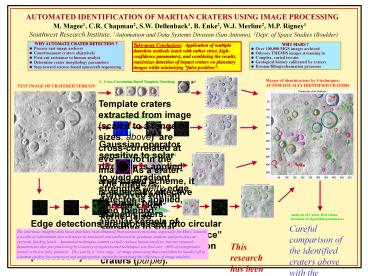AUTOMATED IDENTIFICATION OF MARTIAN CRATERS USING IMAGE PROCESSING PowerPoint PPT Presentation
1 / 1
Title: AUTOMATED IDENTIFICATION OF MARTIAN CRATERS USING IMAGE PROCESSING
1
AUTOMATED IDENTIFICATION OF MARTIAN CRATERS USING
IMAGE PROCESSING
M. Magee1, C.R. Chapman2, S.W. Dellenback1, B.
Enke2, W.J. Merline2, M.P. Rigney1
Southwest Research Institute, 1Automation and
Data Systems Division (San Antonio), 2Dept. of
Space Studies (Boulder)
Take-away Conclusions Application of multiple
detection methods (each with rather strict,
high-confidence parameters), and combining the
results, maximizes detection of impact craters on
planetary images while minimizing false
positives.
Merger of identitications by 4 techniques
AUTOMATICALLY IDENTIFIED CRATERS
1. Cross-Correlation Based Template Matching
TEST IMAGE OF CRATERED TERRAIN
Template craters extracted from image (scaled to
a range of sizes, above) are cross-correlated at
every spot in the image. As a crater-area-based
scheme, it is especially effective for small,
bowl-shaped craters.
2. Directional Edge Based Detection
Gaussian operator sensitive to solar direction is
applied to yield gradient strengths (left) edge
detector is applied, then thinned annular
kernels of varying radii are applied to find
circular craters.
3. Convolution with an Annular Crater Kernel
The image is convolved with an annular crater
kernel (also sensitive to solar illumination
direction) to find craters (purple).
4. Circular Hough Transform
Analysis of Crater Detections, iteration of
algorithm parameters
Edge detections are processed into circular arcs
and parameterized into Hough space (x,y,r,
above) accumulation and arbitration processes
yield craters.
Careful comparison of the identified craters
above with the original image to the left shows
generally good results. But several craters
may, in fact, be unusual junctures of valleys and
other non-impact features. At some point, even
the human image interpreter cannot be surebut we
believe that considerable further improvements in
the automatic techniques are possible. We are
not yet sure that they can eventually replace
human analysts or assist autonomous, real-time
sequencing decisions on-board spacecraft.
The enormous imaging data bases that have been
obtained from planetary missions, especially for
Mars, contain a wealth of information that will
never be measured and synthesized by graduate
students and post-docs at currently funding
levels. Automated techniques cannot yet fully
replace human analysts, but our research
demonstrates that pre-processing by a variety of
sophisticated techniques can find over 80 of
recognizable craters with few false positives.
This can be a first stage of image processing
that could then be handed off to a human analyst
for correction and augmentation, markedly
increasing the efficiency of image analysis.
This research has been supported by an Internal
Research and Development grant from Southwest
Research Institute, through its SwIM Initiative

